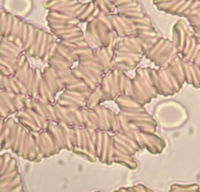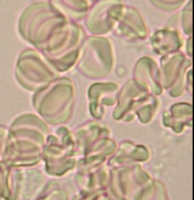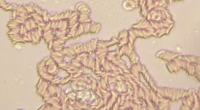Oxygen and Oxygenation
Many live blood samples I see show the marker “rouleau” which means “stacked coin” in French. The red blood cells literally stack up like coins. While this marker is better than having Red Blood Cell Aggregation, it still is concerning and I call this “sticky blood”
 What Rouleau means is the person has poor oxygenation of their blood. Low hemoglobin, infections, digestive issues, low energy, pH imbalance and toxicity can affect oxygenation. The picture to the left vividly demonstrates how impossible it is for the red blood cells to circulate and transport oxygen.
What Rouleau means is the person has poor oxygenation of their blood. Low hemoglobin, infections, digestive issues, low energy, pH imbalance and toxicity can affect oxygenation. The picture to the left vividly demonstrates how impossible it is for the red blood cells to circulate and transport oxygen.
From a health perspective, this condition is an accident waiting to happen. The symptoms of poor oxygenation include pallor and fatigue, poor circulation to the extremities (cold hands and feet), and sometimes dizziness or mental fuzziness. The psychological symptoms are subtle: lack of fortitude, an easy sense of defeat, conviction that the effort needed to do something cannot be made, vulnerability, and perhaps even some disorientation.
It is generally understood that unhealthy cells do not have normal cellular respiration. In simple terms, this means that they derive their energy from fermentation—break down of tissue—rather than oxygen. In the absence of oxygen, cells weaken or die, or they may mutate into something more primitive that can survive without oxygen.
 Initially, the tissues that are lacking sufficient oxygen may be cooler, but as the “terrain” becomes more compromised due to deficiency of the requisite oxygen and nutrients, the devitalized tissues may break down. This is called cellular debris. The area may then become acidic and hot which are key notes for inflammation.
Initially, the tissues that are lacking sufficient oxygen may be cooler, but as the “terrain” becomes more compromised due to deficiency of the requisite oxygen and nutrients, the devitalized tissues may break down. This is called cellular debris. The area may then become acidic and hot which are key notes for inflammation.
Causes of Oxygen Deficiency
There are many reasons that tissues become oxygen deficient: the air breathed may be devitalized; the individual may not breathe deeply enough; there may be too few red blood cells; the red blood cells may be too clumped together to circulate properly; the erythrocytes may be too compromised to perform the work of transporting oxygen .
Deformed, infected, and hemoglobin deficient red blood cells are incapable of proper oxygen transport. If you watch live blood in a microscope, you can observe countless conditions that would account for the oxygen deprivation experienced by various tissues of the body.
In healthy blood, the red blood cells are quite round and approximately the same size. None are deformed or misshapen.
 Many people are more visual than literal so pictures speak to those people; and I am sure that given a choice, most would prefer blood where each cells is floating independently.
Many people are more visual than literal so pictures speak to those people; and I am sure that given a choice, most would prefer blood where each cells is floating independently.
To understand the need for high quality blood, keep in mind that the red blood cells transport nutrients as well as oxygen to all tissues of the body. Then, they collect waste materials and carbon dioxide and discharge this payload in the lungs. Obviously, this makes the lungs highly vulnerable to disease. Red blood cells circulate in plasma, a straw-colored liquid that should be a bit alkaline. Plasma is 90% water and 10% dissolved substances, mainly protein plus some electrolytes and hormones—all crucial to health.
The quality of the plasma corresponds directly to what is ingested, including medicines, herbs, supplements, and food. Plasma becomes more acidic when breathing is shallow or slow. My observation of live blood suggests that erythrocytes are acutely sensitive to chemical changes, toxins, and other substances and life forms in the plasma. Harsh chemicals can cause damage to both the red and white blood cells, but the red blood cells are practically helpless when they cannot escape a hostile condition in the plasma in which they are suspended.
Thanks to the ability to observe the blood before and after various dietary and supplement changes, I have some thoughts that are not readily found elsewhere. For instance, the Ayurvedic theory is that the first tissues to be affected by food and medications are the liquid components of the body. This makes implicit sense. We know that alcohol goes into the blood stream fast. However, if you want to gain (or lose) weight or increase muscle mass, you expect the changes will take longer. Likewise, you know that even after tipping the bottle a little too much, you will probably recover in a few hours. In fact, I have seen changes in the blood in as little as 20 minutes following ingestion of a remedy. Sometimes improvements after is practically immediate, and the blood will tend to look quite marvelous in three days. I have tested blood 20 minutes after a green juice with a little basil (because it contains O7 which breaks down in separate oxygen molecules) and it looks amazing. Parsley and ginger stimulate the stomach to perform its work better. Cucumbers are cooling, too cooling for some people, but they are cleansing.
When the patient is parasitized, there can be anemia due to the amount of blood consumed by the invaders. Body chemistry can be severely affected by parasites, but once you see them eating, you have a completely new appreciation for the word “anemia.” Likewise, mold tends to lyse red blood cells. People with severe mold infections may be cold and deficient in the nutrients needed to maintain health. Only after you have seen this live can you really appreciate some of the factors undermining the tendency of the body to heal itself.
Infection is a little different. It tends to disturb the membranes of the red blood cells so the cells stick together. If you watch this in live blood, you see the white blood cells cleaning the surfaces of the red blood cells. The red blood cells will sometimes turn as if to say, “Lick me here, now here.” Then, they move off and another asks for help. They move much better after the white blood cells have rendered this service so the last thing one wants to do is compromise the ability of the white blood cells to perform their work efficiently.
I have developed tonics and tinctures for virtually every condition I have observed. This said, there are some readily available blood tonics that you can find in some health foods stores.. I formulated one very general tonic using goji berries. These have been researched in conjunction with cancer, including patients undergoing conventional therapy. I added herbs that are known to help the liver (the master mind of the blood) milk thistle to protect the liver, hawthorn berries for the heart, astragalus for immunity, dandelion for digestion and assimilation, and cinnamon bark for taste and stimulation of the secretion of gastric juices. I have another very general formula for supporting the rebuilding of hemoglobin. It contains yellow dock and uses molasses as a carrier because molasses contains so many trace minerals and almost nothing improves the appearance of red blood cells like good quality minerals.
Everyone is slightly different. There are many causes of Rouleau. The blood tells us a story and warns us of where things are at or could go. It is a fascinating look into the little world.




